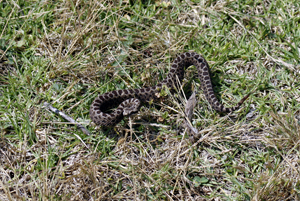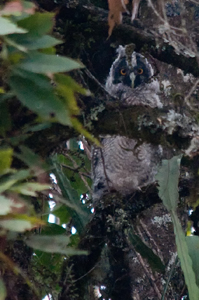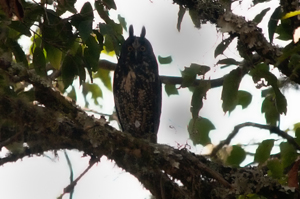 |
Crotalus transversus, a rare Mexican rattlesnake
Note: Terry Cloudman has some pictures from this trip that are not included in the Annual Report. See
http://terryc.smugmug.com/Travel/Mexico-Birding/12432197_EUWoV#889925110_RqzDD.
This trip was a pure birding trip, concentrating on endemic species of Western Mexico. We did have time for a few other things, though, such as the nice rattlesnake whose photo appears at left. We were walking down a gravel road when I notice the snake moving at my feet. “Here's a small snake,” I said. Our driver, David, picked up a stick and forced the snake to rear up. It was only about 18" (45cm) long and not a threat to anyone, despite the rattles at the end of its tail.
 |
Stygian Owl Poult (Asio stygius)
Michael did some research later and informed us it was quite rare. Wikipedia claims it is known from only 20 specimens, and also that our snake was probably an adult, as the maximum length cited is only 46.5cm.
 |
Female Stygian Owl (Asio stygius)
The highlight of the trip for most of us was a sighting of the Stygian Owl. Michael explained that we had the best chance of finding one at dawn, rather than dusk, and got us out of bed at 3:00 a.m. for the two hour drive up the mountain to the spot where he had seen one before. We heard it calling, in fact, we heard a male and female calling to each other. The male flew over our head, showing us a brief silhouette against the lightening sky. Not the best view, but a “countable tick.”
At lunch, Michael left us to see if he could locate the tree they were roosting in. He returned with a big smile, and proceeded to lead us back to the spot. There, we had an extra treat: two poults, young owls still in downy chick plumage. Terry managed to get photos, which I have borrowed for this write-up.
At first, we saw only one of the chicks, but Jenny realized from our description that she was looking at a different bird and pointed out the second chick.
The signature bird of the trip is the Short-crested Coquette (Lophornis brachylophus), which we all saw well, albeit only a female. We saw many other very specialized birds on the trip with very restricted ranges. Probably the most endangered bird of the trip is the Sierra Madre Sparrow (Xenospiza baileyi), whose habitat is being cleared to make pastures. Michael showed us a pair and said, “You're looking at the entire range of this bird.”
Mexico has been devastated by the global economic problems. Oil has declined, tourism is down — indeed several people thought we were crazy to go there, and remittances from Mexicans working in the USA have dried up. We saw the impact everywhere. In Taxco, which I remember visiting as with family when I was young, had been a standard day trip for busloads of tourists coming from Mexico City. Now, it lay dormant, shops closed, buses gone, people with nothing to do. We had trouble finding restaurants that were open.
Here are some photos from the trip?


